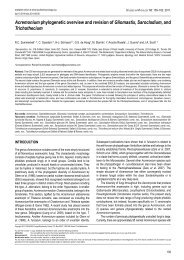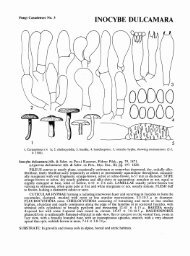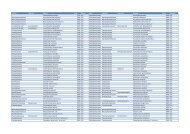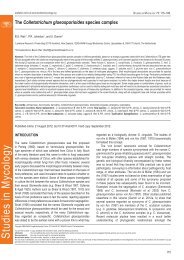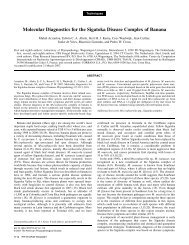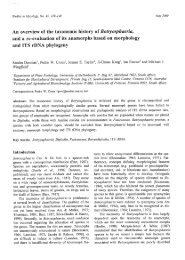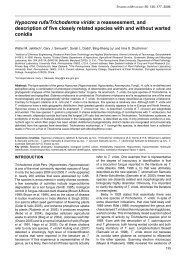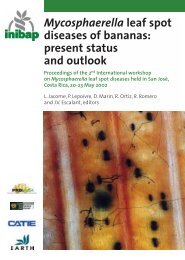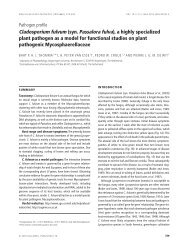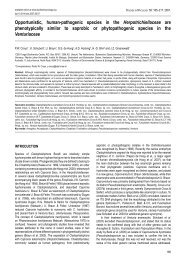Phylogenetic lineages in the Capnodiales - Cbs - KNAW
Phylogenetic lineages in the Capnodiales - Cbs - KNAW
Phylogenetic lineages in the Capnodiales - Cbs - KNAW
You also want an ePaper? Increase the reach of your titles
YUMPU automatically turns print PDFs into web optimized ePapers that Google loves.
www.studies<strong>in</strong>mycology.org<br />
<strong>Phylogenetic</strong> l<strong>in</strong>eageS <strong>in</strong> <strong>the</strong> <strong>Capnodiales</strong><br />
Fig. 11. Hortaea thailandica. A. Cercosporoid leaf spots on Syzygium siamense, <strong>in</strong> which H. thailandica occurred. B. Colonies on OA. C–E. Hyphae with conidiogenous loci<br />
(arrows). F–H. Conidia. Scale bars = 10 µm.<br />
Davidiellaceae C.L. Schoch, Spatafora, Crous & Shoemaker,<br />
Mycologia 98: 1048. 2006.<br />
Type species: Davidiella tassiana (De Not.) Crous & U. Braun,<br />
Mycol. Progr. 3: 8. 2003.<br />
Notes: The Davidiellaceae was <strong>in</strong>troduced for <strong>the</strong> genus Davidiella,<br />
which has Cladosporium anamorphs. As shown <strong>in</strong> <strong>the</strong> present<br />
analysis, however, allied genera such as Toxicocladosporium,<br />
Verrucocladosporium, Rachicladosporium and Graphiopsis also<br />
belong <strong>in</strong> this family. Of <strong>in</strong>terest is <strong>the</strong> position of Melanodothis caricis<br />
<strong>in</strong> Cladosporium s. str. This fungus, which <strong>in</strong>fects florets of Carex<br />
and Kobresia, forms a stroma that gives rise to several immersed<br />
ascomata with bitunicate, oblong asci that are aparaphysate, and<br />
0–(2)-septate, hyal<strong>in</strong>e, 9–14.5 × 2–4 µm ascospores. In culture,<br />
a hyal<strong>in</strong>e, Ramularia-like anamorph developed, with sympodial<br />
proliferation, catenulate conidia, with thickened, darkened loci<br />
(Arnold 1971). Although <strong>the</strong>se characteristics are atypical of <strong>the</strong><br />
Davidiella/Cladosporium species <strong>in</strong> this clade, <strong>the</strong> position of<br />
Melanodothis caricis <strong>in</strong> this family cannot simply be disregarded.<br />
However, <strong>the</strong> ex-type culture of this fungus (CBS 860.72) proved<br />
to be sterile.<br />
A fur<strong>the</strong>r unconfirmed sequence (CBS 354.29, culture sterile,<br />
but fast grow<strong>in</strong>g, grey-brown, Cladosporium-like), is that submitted<br />
as Sphaerul<strong>in</strong>a polyspora. The culture was accessioned <strong>in</strong> 1929,<br />
deposited by A.E. Jenk<strong>in</strong>s, and <strong>the</strong>re is reason to believe that it<br />
was derived from BPI 623724!, which is au<strong>the</strong>ntic for <strong>the</strong> species,<br />
and collected by F.A. Wolf <strong>in</strong> May 1924. Wolf (1925) described this<br />
fungus from twigs of Oxydendron arboretum with die-back disease<br />
symptoms, collected <strong>in</strong> Raleigh, North Carol<strong>in</strong>a. Sphaerul<strong>in</strong>a<br />
polyspora (623723 = Type!) has pseudo<strong>the</strong>cia with aparaphysate,<br />
bitunicate asci, and ascospores that are hyal<strong>in</strong>e, 3–5-septate, 20–<br />
24 × 6–7 µm. On <strong>the</strong> host it was l<strong>in</strong>ked to a Phoma-like anamorph,<br />
which also grew similar <strong>in</strong> culture (yeast-like budd<strong>in</strong>g), and has<br />
hyal<strong>in</strong>e conidia which are ellipsoidal, 7–8 × 3.8–4 µm.<br />
Colonies were reported as slow-grow<strong>in</strong>g, grey, appressed,<br />
with germ<strong>in</strong>at<strong>in</strong>g ascospores form<strong>in</strong>g yeast-like budd<strong>in</strong>g cells, and<br />
rarely hav<strong>in</strong>g hyphae that extended from <strong>the</strong> marg<strong>in</strong> of <strong>the</strong> colonies.<br />
The l<strong>in</strong>k between Sphaerul<strong>in</strong>a-like species, with Selenophoma<br />
and Aureobasidium synanamorphs was recently illustrated<br />
by Cheewangkoon et al. (2009). Although members of <strong>the</strong><br />
Dothideomycetes, <strong>the</strong>se taxa do not cluster <strong>in</strong> <strong>the</strong> Davidiellaceae,<br />
and hence it seems a fair assumption that CBS 354.29 is not<br />
representative of Sphaerul<strong>in</strong>a polyspora.<br />
Rachicladosporium cboliae Crous, sp. nov. MycoBank<br />
MB514704. Fig. 12.<br />
Etymology: Named after <strong>the</strong> Consortium for <strong>the</strong> Barcode of Life,<br />
CBOL, who organised a Fungal Barcod<strong>in</strong>g Symposium, dur<strong>in</strong>g<br />
which this fungus was collected.<br />
Rachicladosporio americano similis, sed conidiophoris dense fasciculatis et conidiis<br />
m<strong>in</strong>oribus.<br />
41




